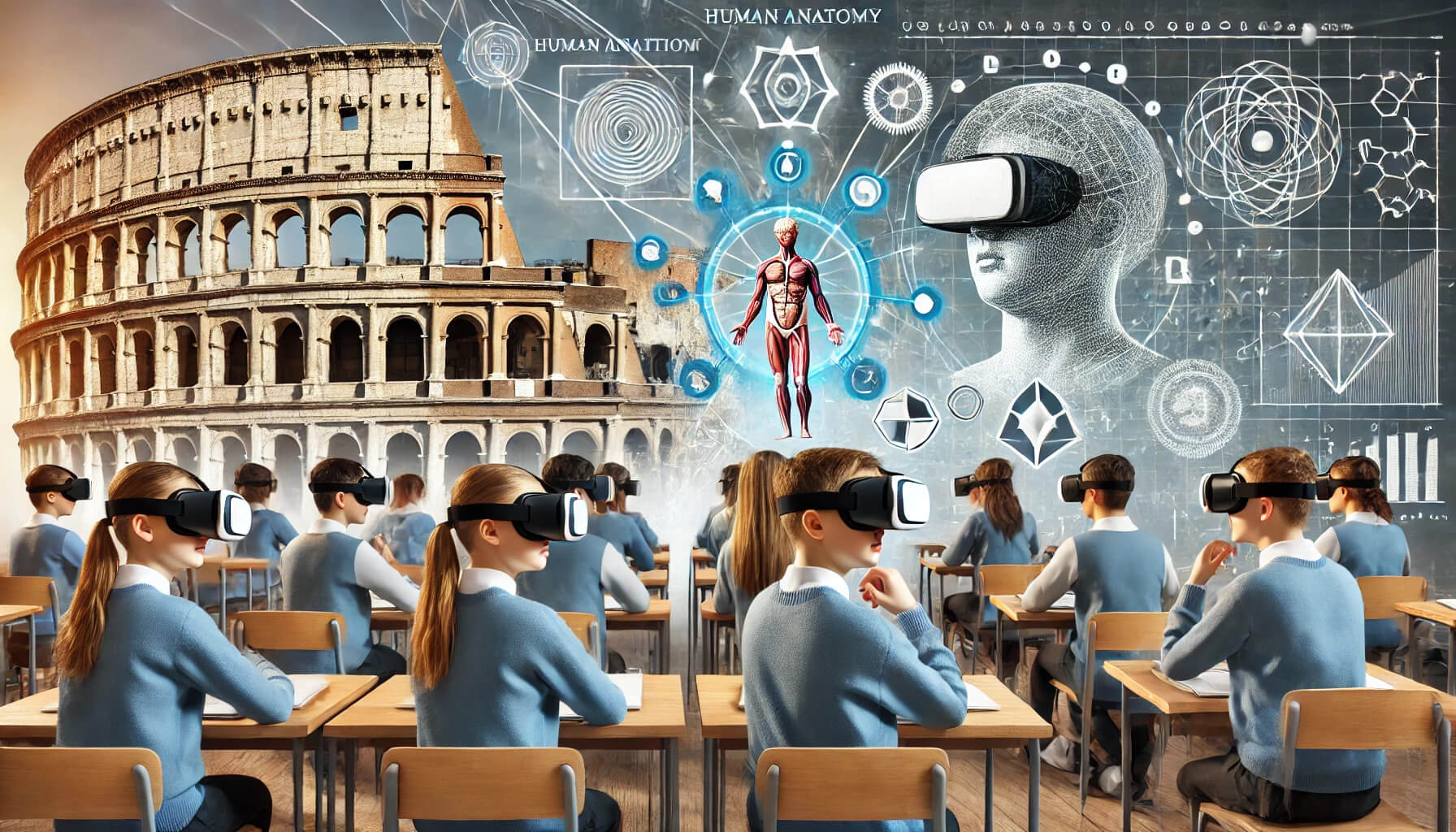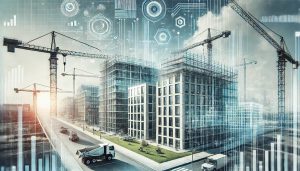A Journey Through Time and Space with VR
Imagine stepping into the heart of ancient Rome, walking through the Colosseum, and hearing the crowd’s roar, all from the comfort of your classroom. Or, consider the possibility of medical students performing complex surgeries without the risk of a real-life operation. These scenarios, once figments of science fiction, are now realities thanks to Virtual Reality (VR) technology.
VR in education is not just about visual spectacle; it’s a transformative tool for interactive, immersive learning that enhances understanding and retention. This blog explores how VR is being integrated into educational systems, reshaping traditional learning paradigms, and creating new opportunities for both students and educators.
VR in Education: The Journey from Concept to Classroom
- Historical Context and Evolution
The concept of VR isn’t new; it dates back to the 1950s when Morton Heilig, a cinematographer, conceptualised an experience theatre that could encompass all the senses in an effective manner. However, it wasn’t until the late 20th century that VR started to find its footing in practical applications.
Fast forward to today, and VR technology has advanced by leaps and bounds, becoming an accessible tool in educational settings. Recent advancements have not only decreased the cost of VR headsets but also increased their availability, making VR a feasible tool for schools across the globe.
- Technology Behind VR
At its core, VR technology includes headsets like Oculus Rift, and HTC Vive, or simpler devices like Google Cardboard, which pair with smartphones. These devices use stereoscopic displays to create a three-dimensional space that can simulate any environment for educational purposes.
Software applications, developed on platforms such as Unity or Unreal Engine, provide the content that brings lessons to life, allowing students to interact with the material in a wholly immersive way.
Curriculum Enhancement Through VR
- Mathematics
- Visualising Complex Concepts
VR transforms abstract mathematical concepts into visible and interactive scenarios that students can manipulate. For example, geometry students can explore different shapes and forms in a three-dimensional space, making it easier to understand volumes and surface areas.
- Interactive Problem Solving
Through VR, students can engage in complex problem-solving scenarios that would be difficult or impossible to replicate in a traditional classroom. This could involve real-time data manipulation and the application of mathematical theories to solve practical problems.
- Science
- Biology
VR can take students inside the human body to explore organs and systems on a scale that provides a much deeper understanding of human anatomy than textbooks or static images could ever achieve.
- Physics
Students can experiment with physical laws in safe, controlled virtual environments, observing the effects of changes in gravity or momentum, without the physical risk or resource constraints.
- Chemistry
VR allows students to construct, deconstruct, and visualise chemical reactions at a molecular level, offering insights into the building blocks of matter.
- History and Social Studies
- Historical Reconstructions
VR allows students to visit historical sites and witness historical events as if they were there. This could include walking the streets of ancient civilisations, participating in significant historical events, or understanding the evolution of cultures over centuries.
- Interactive Problem Solving
Students can experience the traditions, arts, and social structures of different cultures through immersive VR storytelling, enhancing their understanding and appreciation of global diversity.
- Literature and Languages
- Literary Journeys
VR can transport students into the worlds of their favourite books, exploring settings and interacting with characters, thus bringing literature to life in a vivid and engaging manner.
- Language Immersion
Language learning through VR can mimic immersion experiences, allowing students to practice speaking and listening in realistic scenarios with native speakers, without the travel.
- Visual and Performing Arts
- Art Creation and Exploration
VR technology enables students to create art in three-dimensional spaces, offering a new medium for expression and creativity. They can also visit virtual art galleries and museums to study artworks from around the world.
- Music and Performance
Students can participate in virtual music classes, perform in virtual concerts, and even compose music using VR tools, which provide a wide range of instrumental sounds and orchestral arrangements.
- Geography
- Virtual Field Trips
VR excursions can take students to remote parts of the world to study geographical features, environmental issues, and diverse ecosystems, all from their classrooms.
- Urban Planning and Sustainability
Through VR simulations, students can engage in urban planning challenges, exploring sustainable development solutions and the impacts of urbanisation on environments.
- Health and Physical Education
- Sports Training
VR can be used to teach various sports techniques, providing a safe environment where students can practice skills and strategies relevant to different sports.
- Wellness and Health Education
VR applications can help teach students about nutrition, human anatomy, and other health-related topics in an engaging and interactive way.
Overcoming Educational Barriers with VR
- Accessibility and Inclusion
Virtual Reality is heralded not only for its immersive capabilities but also for its potential to make education more inclusive and accessible. Here’s how VR is breaking down barriers:
- Physical Disabilities
VR allows students with physical disabilities to engage in activities and experiences that are otherwise inaccessible. For example, a student in a wheelchair can participate in virtual field trips or physical activities using VR simulations.
- Learning Differences
For students with learning disabilities, VR provides customizable learning environments where the pace and mode of instruction can be adjusted to meet individual needs, helping to sustain engagement and enhance understanding.
- Remote Accessibility
VR can bridge geographical gaps by bringing the classroom experience to students in remote areas, ensuring that high-quality education is not confined to urban centres but is accessible to students regardless of their location.
Integration Challenges and Practical Solutions
While the benefits are compelling, integrating VR into mainstream education systems presents several challenges. Here’s an exploration of these issues along with practical solutions:
- High Costs
The initial setup cost for VR, including hardware like headsets and the necessary computing power, can be prohibitive for many institutions.
Solution:
Schools can explore grants, partnerships with technology companies, and phased implementations to spread out costs. Additionally, shared resource centres where multiple schools use a centralised set of VR equipment can reduce individual school costs.
- Technical Infrastructure
Implementing VR requires a robust technical infrastructure, including high-speed internet and compatible hardware.
Solution:
Schools can start small with pilot programmes to gauge infrastructure needs and expand as technological capacity grows. Partnering with tech firms for infrastructure audits and support can also be beneficial.
- Curriculum Integration
Aligning VR content with existing curricular goals and standards poses another significant challenge.
Solution:
Professional development for educators is crucial. Training teachers not only on the technical use of VR but also on integrating VR experiences into their lesson plans will be key. Furthermore, curriculum developers can work alongside VR content creators to ensure that educational materials meet learning standards and are pedagogically sound.
- Teacher Readiness and Training
There is often a gap in the skills and confidence required by teachers to effectively use VR in their teaching.
Solution:
Ongoing training and support systems are essential. Workshops, continual professional development sessions, and in-house tech support can empower teachers to become proficient in using VR technology.
The Psychological Impact of VR in Education
Understanding the psychological impact of VR is critical to ensure it benefits students without causing harm. Here’s what needs consideration:
- Cognitive Overload
Immersive VR experiences can be intense, and there’s a risk of cognitive overload where the student finds the VR environment too complex or overwhelming.
Educators should design VR experiences that are age-appropriate and complexity-appropriate, ensuring that the virtual environments are conducive to learning without overstimulation.
- Social Interaction
While VR can simulate interactive environments, the concern remains that excessive use could impact real-world social skills.
Incorporating VR as a complement rather than a replacement for traditional learning can help. Ensuring that VR activities have social components and promoting group activities within the VR space can also support social learning.
By addressing these barriers and considering the psychological impacts, VR can be more effectively integrated into educational frameworks, maximising its benefits while minimising potential drawbacks. This careful approach ensures that VR is a tool that enriches the educational landscape rather than complicating it.
Comparative Analysis with Other Technologies
Virtual Reality (VR) stands out among educational technologies for its immersive and interactive capabilities. However, a comparative analysis with other educational tools can highlight its unique advantages and potential drawbacks:
- Benefits Over Traditional Educational Tools
- Immersive Experience
Unlike textbooks or static media, VR engages students in a fully immersive environment, making learning an active rather than passive experience. This can lead to higher engagement rates and better retention of information.
- Interactive Learning
VR allows students to interact with their learning environment, conduct experiments, and manipulate variables in real time, which is not possible with traditional learning tools like textbooks or even many e-learning platforms.
- Comparative Efficiency with E-learning Platforms
- Engagement and Retention
Studies suggest that VR can significantly improve retention and recall due to its immersive nature, compared to traditional e-learning platforms that may not fully captivate the user’s attention.
- Practical Skills Development
VR simulations offer hands-on experience in a virtual setting, providing practical skills and real-world scenario training that e-learning platforms can typically only teach theoretically.
- Challenges Compared to Other Technologies
- Cost and Accessibility
While e-learning platforms can often be accessed with simple internet connectivity and basic computing equipment, VR requires more specific and sometimes costly hardware, making it less accessible for widespread adoption.
- Content Development
Developing or procuring high-quality VR content can be more complex and resource-intensive compared to creating traditional educational content or using existing e-learning materials.
Parental and Community Engagement
The successful integration of VR into educational systems not only depends on the technology and educators but also on support from parents and the community. Here’s how these groups can be effectively engaged:
- Educating Parents and Guardians
- Awareness and Workshops
Schools can organise workshops and demonstrations for parents to showcase how VR is used in the classroom and its benefits. This helps in building trust and understanding of the technology’s educational value.
- Communication
Regular updates on VR activities and student progress can be communicated through newsletters, emails, or school portals, keeping parents informed and engaged with their child’s learning journey.
- Community Involvement
- Community Funding and Support
Engaging local businesses, educational foundations, and community groups to fund or donate VR equipment can help alleviate financial burdens on schools.
- Public Demonstrations
Hosting public events where community members can experience VR firsthand can garner support and excitement around VR educational programmes.
- Feedback Mechanisms
Establishing channels for community feedback on VR programmes helps schools adjust and improve their VR offerings based on real-world input and concerns.
The Immediate Impact of VR on Education
Virtual Reality holds the promise to transform education by making learning a more immersive, engaging, and effective process. It offers the potential to bring abstract concepts to life, provide hands-on experience in a safe environment, and prepare students for future challenges in an increasingly digital world.
Schools and educational policymakers are encouraged to consider the integration of VR technologies not as a futuristic vision but as a practical enhancement to contemporary education. By fostering collaborative efforts among technology providers, educators, and community stakeholders, VR can be effectively integrated to enrich educational landscapes across the globe.
FAQs
- What Is Virtual Reality (VR) in Education?
Virtual Reality in education refers to the use of VR technology to create an immersive learning environment where students can interact with 3D simulations and experiences. This technology enables learners to visualise complex concepts, participate in virtual field trips, and engage in interactive educational activities that would be impossible or impractical in the real world.
- How Does VR Enhance Learning?
VR enhances learning by making educational content more engaging and interactive. It allows students to experience and interact with subject matter in a hands-on way, which can improve understanding and retention. For example, through VR, students can explore the human body in a biology class or visit ancient civilisations in a history lesson.
- How Does Virtual Reality Differ from Augmented Reality in Educational Settings?
Virtual Reality (VR) immerses users in a completely virtual environment that is typically accessed via a VR headset. In contrast, Augmented Reality (AR) overlays digital information into the real world, which can be accessed through smartphones or AR glasses. In educational settings, VR is used for fully immersive experiences, such as virtual field trips or complex simulations, whereas AR enhances real-world environments with additional information, making it useful for interactive textbooks or anatomy classes.
- What Are the Psychological Effects of Using VR in Education for Children?
While VR can offer engaging and interactive learning experiences, it’s important to consider its psychological impact on children. Potential effects include increased spatial awareness and improved problem-solving skills. However, overuse can lead to issues like motion sickness or decreased attention span. It’s crucial to balance VR usage with traditional learning methods and ensure content is age-appropriate.
- What Infrastructure is Required to Implement VR in Schools?
Implementing VR in schools requires specific hardware, such as VR headsets and compatible PCs or mobile devices, as well as a stable internet connection to download or stream VR content. Schools also need space to safely use VR equipment, especially for activities that require physical movement. Additionally, proper training for educators is essential to effectively integrate VR into the curriculum.
- How Can Teachers Incorporate VR into Their Existing Curriculum?
Teachers can incorporate VR into their curricula by identifying areas where VR can enhance understanding or provide unique experiences. For instance, VR can be used for virtual lab experiments in science classes or historical reenactments in history lessons. Starting with specific projects or modules can help integrate VR gradually, assessing its impact and effectiveness before a wider implementation.







No comment yet, add your voice below!